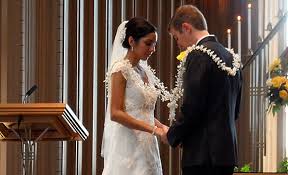Marriage traditions vary widely across cultures, each reflecting the unique values, beliefs, and histories of different societies. While some traditions might seem unusual to outsiders, they often hold deep significance and symbolism for those who practice them. This article explores some of the most unusual marriage traditions from around the globe, highlighting the diverse ways in which people celebrate this important life event.
1. The Tradition of Throwing the Bride in the Air: France

In the French region of Brittany, there is a unique wedding tradition known as “La Mariée en l’air,” or “The Bride in the Air.” During the wedding reception, the bride is lifted into the air by the guests, who take turns tossing her up and down. This playful and exhilarating tradition is meant to symbolize the joy and celebration of the new union. While it may seem unconventional to outsiders, it’s a cherished part of the wedding festivities in Brittany.
2. The Shoe Throwing Ritual: South Korea
In South Korea, a traditional wedding ceremony includes a unique and symbolic ritual involving shoes. After the wedding ceremony, the groom’s shoes are taken off and placed on the floor. The bride’s family members then take turns throwing the groom’s shoes at him. The number of hits is said to represent the number of children the couple will have, with each hit symbolizing a child. This ritual is both a playful way to celebrate the marriage and a symbolic gesture of welcoming the groom into the bride’s family.
3. The Ringing Ceremony: Russia
In Russia, a distinctive wedding tradition involves a “ringing ceremony,” where the bride and groom exchange rings in a unique manner. The rings are placed in a small, decorative box, and the couple then rings a bell together to signify their union. This tradition is believed to symbolize the couple’s commitment to each other and their desire to live a harmonious life together. The sound of the bell is thought to ward off any negative spirits and bring good fortune to the marriage.
4. The Spitting Ritual: Maasai of Kenya
Among the Maasai people of Kenya, an unusual marriage tradition involves a ritual where the groom’s family members spit on the bride as a sign of acceptance. This practice, though seemingly strange to outsiders, is deeply rooted in Maasai culture. The act of spitting is believed to bless the bride and signify her acceptance into the groom’s family. It is considered a gesture of goodwill and respect, reflecting the strong bond between the two families.
5. The Tying of the Knot: India
In many Indian weddings, particularly in the northern states, a traditional ritual called “Knot Tying” takes place. During this ceremony, the bride and groom are seated together, and their garments are tied in a knot. This symbolic act represents the couple’s commitment to each other and their intention to stay together through thick and thin. The knot is often tied with a sacred thread, and the ritual is accompanied by prayers and blessings from the family and guests.
6. The Tea Ceremony: China
The Chinese tea ceremony is an integral part of many traditional weddings in China. During this ritual, the bride and groom serve tea to their parents and close family members as a sign of respect and gratitude. The tea ceremony is a way to honor the couple’s ancestors and seek blessings for their future together. The tea served is often accompanied by symbolic gifts, such as red envelopes containing money, which are given to the couple as tokens of good luck and prosperity.
7. The Lasso Ceremony: Mexico

In Mexican weddings, a unique tradition known as the “Lasso Ceremony” is often performed. During this ritual, a lasso, usually made of flowers or beads, is placed around the couple’s shoulders or necks in a figure-eight shape. This symbolizes the couple’s union and their commitment to each other. The lasso is often blessed by a priest or officiant, and the ceremony is meant to represent the couple’s bond and the strength of their relationship.
8. The Bride Kidnapping Tradition: Romania
In some regions of Romania, a playful and unusual wedding tradition involves “bride kidnapping.” During the wedding festivities, the bride is “kidnapped” by friends or family members and taken to a different location. The groom must then go on a quest to retrieve his bride, often involving humorous and lighthearted challenges. This tradition is meant to celebrate the bride’s transition to her new life and provide entertainment for the wedding guests.
9. The Bamboo Dance: Philippines
In the Philippines, particularly in the Visayan region, a unique wedding tradition involves a “Bamboo Dance.” During the reception, the bride and groom participate in a traditional dance where they step between two long bamboo poles that are rhythmically clapped together by other dancers. The dance is a symbolic representation of the couple’s ability to navigate challenges and obstacles together. It’s a lively and energetic way to celebrate the couple’s union and entertain the wedding guests.
10. The Rock-Paper-Scissors Game: Japan
In some Japanese weddings, a fun and unconventional tradition involves playing a game of rock-paper-scissors. The couple engages in the game with their guests to determine who will win various prizes or rewards. This lighthearted tradition adds an element of fun and excitement to the wedding festivities and allows guests to participate actively in the celebration.
11. The Fast-Food Wedding: USA
In certain regions of the United States, especially among younger couples, an unconventional wedding tradition involves having a fast-food-themed wedding. This trend includes incorporating fast-food items, such as burgers, fries, and chicken nuggets, into the wedding reception menu. Some couples even choose to have their wedding ceremony at a fast-food restaurant. This modern and quirky tradition reflects the couple’s love for fast food and adds a unique and personalized touch to their special day.
12. The Fainting Tradition: Spain
In Spain, particularly in the region of Catalonia, a wedding tradition known as “La Fainting” involves the bride or groom fainting during the ceremony. This dramatic gesture is performed to symbolize the emotional weight and significance of the marriage. It is often accompanied by dramatic music and theatrical elements, adding an element of spectacle to the wedding.
13. The Big Wedding Feast: Ethiopia
In Ethiopia, particularly among the Oromo people, a traditional wedding involves a grand feast known as “Gabbana.” During this feast, the entire community is invited to celebrate the couple’s union. The feast includes a variety of traditional dishes, music, and dance, and is a significant social event for the community. The Gabbana is a way to honor the couple and their families, and it reflects the importance of community and togetherness in Ethiopian culture.
14. The Wedding Cattle Gift: Nigeria

In many Nigerian cultures, particularly among the Yoruba and Hausa people, a traditional wedding involves the gifting of cattle from the groom’s family to the bride’s family. This practice, known as “Bride Price,” is a symbolic gesture of respect and appreciation for the bride and her family. The number of cattle given can vary depending on the family’s status and the couple’s preferences.
15. The Skipping Tradition: Scotland
In Scotland, a unique wedding tradition involves the “Skipping” ceremony. During this ritual, the bride and groom are lifted by their family and friends and skipped around the wedding venue. This lively and energetic tradition is meant to symbolize the couple’s joyous union and their ability to overcome any obstacles together.
Conclusion
Marriage traditions around the world offer a fascinating glimpse into the diverse ways cultures celebrate this significant life event. From the playful and unusual to the deeply symbolic, these traditions reflect the unique values, beliefs, and histories of different societies. Understanding and appreciating these customs not only enriches our knowledge of global cultures but also highlights the universal nature of love and commitment.
Whether it’s the exuberant celebration of “La Mariée en l’air” in France, the symbolic “Lasso Ceremony” in Mexico, or the playful “bride kidnapping” in Romania, these traditions showcase the creativity and diversity of human expression. Embrace these traditions and recognize the beauty and significance they bring to the celebration of marriage.


